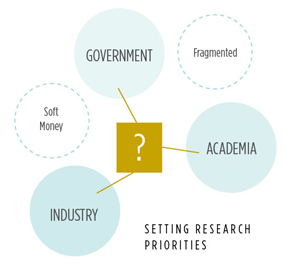It’s time to start playing nice in the sandbox:
Collaborative research in Canada: gaps and strategic solutions
By Allan Paulson1* | Rickey Yada2 | John Webb3
The process of innovation in research is a continuum from fundamental/discovery research through strategic and applied research to product development and launch. This process is critical to global competitiveness and economic viability and may be facilitated through collaborative research among the three potential partners: academia, industry and government. Such research, however, regardless of the sector and/or geographic domain, remains a challenge, the food industry in Canada being no exception. This article discusses some of the issues and challenges of collaborative research in the agri-food industry in Canada
THE FUNDING GAP
Typically in the past, fundamental/discovery research has been addressed through government funding, and near-market research by industry. Recently government incentives and programs have emphasized near-market opportunities, but this still leaves a risk that lack of funds will make it difficult for new ideas to cross the gap between fundamental/discovery research and market opportunity, i.e., a gap often referred to as the “valley of death” where a lack of funding to undertake proof of concept research (or utility of the discovery) often prevents a good idea from being developed (e.g., food processing companies) and marketed. This leaves applied research stranded with uncertain funding and a serious risk of good ideas being lost.
CO-ORDINATION OF RESEARCH
To avoid the gap, the solution is for the three entities, academia, industry and government to work more closely together to identify priorities and ensure that they are well funded from fundamental/discovery right through to product development. However, collaboration and coordination among the parties is not an easy task, with many challenges.
For the food industry, research needs are usually “applied”, pragmatic and relatively short-term. Many food companies, notably SMEs, usually have little money for research, whereas many (if not most) large companies have downsized and outsourced their R&D. In addition, the ownership of IP needs to be clearly defined, and much of the IP exists as trade secrets rather than patents. Confidentiality of the research and its outcomes is essential because those who are “first off the mark” are usually the big winners, rather than “me-too” products.
For university researchers, there are numerous conflicting demands which include such factors as:
1) Time demand: A typical academic must meet the demands of teaching, research and administration, so the amount of time spent on research is much lower than a researcher in government or industry.
2) “Discovery” versus “applied” research: “Discovery” or “fundamental” research is typically more highly valued for career advancement than “applied” research. Similarly, collaborative research is not as highly valued as research where the professor is seen as the sole driver.
3) Longer time-line: Most research funds are obtained by highly competitive proposals to government granting agencies. Most are not designed to rapidly address the research needs of industry. Moreover, university researchers are expected to have long-term research programs rather than short-term projects. Since funding is typically relatively small, a professor’s time for research is limited, and there is a training requirement attached to the grant; most of the research is done by graduate students whose programs consist of coursework and a thesis. The average time to complete a Masters degree is 2 years and 3 years for a Ph.D., which is typically much longer than is needed by industry for a research outcome.
4) Publish or perish: For academics, the focus is usually on publications rather than IP (e.g., patents) for career advancement. In general, most academics have little interest in IP or confidential, applied research, whereas it is crucial for industry. In addition, IP policy varies with the university; with some universities the researcher owns the IP whereas at others, the university owns the IP. This can make it difficult for multi-university collaborative research with industry where clear IP ownership is important.
5) In Canada, we have the additional challenge of geography where we are a vast country with a small population. Our research expertise and resources are scattered, and the research culture is not geared to multi-sectoral collaborative research.
 For both provincial and federal governments, the primary challenge is to develop an effective mechanism to identify and prioritize research directions that will benefit the health and economic wellbeing of Canadians. This must be done while taking into account the wealth and breadth of Canadian research expertise, and the pressures of rapid knowledge transfer and uptake up research, all in times of budget constraints (see discussion below).
For both provincial and federal governments, the primary challenge is to develop an effective mechanism to identify and prioritize research directions that will benefit the health and economic wellbeing of Canadians. This must be done while taking into account the wealth and breadth of Canadian research expertise, and the pressures of rapid knowledge transfer and uptake up research, all in times of budget constraints (see discussion below).
Regardless of the above challenges, research coordination among the various parties is not easy when funding is short term from grant to grant, so-called “soft money”, and research is fragmented across many different institutions, provinces, and vested interests, and provides no core funding for infrastructure. Although short term funding may allow one to respond to emerging issues, long term funding allows for the possibility of developing, testing and refining an innovative concept while respecting the iterative nature of research.
An excellent example of collaborative research was the Advanced Foods and Materials Network (AFMNet, 2003-2010) which was funded through the Networks of Centres of Excellence Program and was Canada’s only national food and bio-materials research network. At its conclusion, AFMNet consisted of over 180 researchers and approximately 639 Highly Qualified Personnel (i.e., undergraduate, graduate, postdoctoral fellows, research associates, visiting scientists) and had partnered with approximately 60 corporations, 40 universities, 20 government agencies and 15 non-governmental organizations resulting in 7 startup companies, 9 patents granted, and 32 patents pending. Unfortunately with the termination of NCE funding, no national research network with direct funding capacity exists to support agri-food research although Advanced Foods and Materials (AFM) Canada Inc. (http://www.afmcanada.ca/) now serves as a linkage hub among the sectors. Evolving from AFMNet (founded in 2003), the organization advances technologies from a range of disciplines to develop innovative solutions to sector-driven problems. As a non-profit organization, AFM Canada enhances the value chain by bridging the investment and communication gap between private organizations, research institutions, and government organizations, and by providing a specialized range of services and expertise for industry-led projects.
Therefore, a good start might be to increase the core funding for centres of excellence, recognizing their strategic importance to the industry. A single body linking academia, industry and government could coordinate funding and manage priority-setting on behalf of all interests. Above all it could review priorities at all stages of the “pipeline” and ensure that promising ideas do get to market and not die for lack of funds. That body would need to be independent in terms of equitably weighing the interests of all parties.
 SETTING RESEARCH PRIORITIES
SETTING RESEARCH PRIORITIES
How then does one identify research priorities? This process, in the face of scarce funding, is never easy. A useful approach is to consider a balanced portfolio of long and short term, fundamental/discovery and applied research against a list of industry drivers of success. The drivers will include traits such as yield, quality, health and sustainability.
A simple 2 x 2 table of long versus short term and fundamental/discovery versus applied (or near-market) can be very instructive. It is quickly clear that a pipeline will not exist without a critical mass of fundamental and long term new research. This is a priority for government core funding. Near-market opportunity will easily attract industry funding. For shorter term fundamental/discovery research, intellectual property rights provide an incentive for industry participation or even outright ownership.
The greatest challenge for funding is the long term but applied combination, where a technology requires a lot of developments to bring into practice and is by definition high-risk. Here a judgment can be taken on strategic value, and where this is high there may be a case for government-industry partnerships. A good way of sharing technology risk in areas of high strategic importance to industry, for example in disease control, is the pre-competitive consortium of companies – an approach successfully used in the livestock industry. The most common failing is that industry does not have an agreed list of research priorities that can be used to inform academia and government.
CONCLUSIONS
Complementary and multidisciplinary collaborative research using a cluster or network approach involving academia, industry and government is a viable solution in identifying and addressing strategic research needs; resulting in commercially viable products and technologies to benefit the health and economic wellbeing of Canadians. Critical to the success of this approach, however, is the ability to coordinate and facilitate such a network or cluster among the various partners with a shared vision for research planning and execution, and the ability to secure long term, committed funding while meeting the various challenges identified above.
- Department of Process Engineering and Applied Sciences – Food Science Program, Dalhousie University, Halifax, NS, Canada; Canadian Institute of Fisheries Technology, Halifax, NS, Canada.
- Department of Food Science, University of Guelph, Guelph, ON, Canada
- Maple Leaf Foods, Toronto, ON, Canada
(*Corresponding author: E-mail: Allan.Paulson@dal.ca)
 Canadian Food Business
Canadian Food Business

